
Choosing yarn for a project can be quite daunting. There are so many fibers and blends available: from workhorse highland wool to merino to alpaca; cotton to bamboo to linen; acrylic, acrylic blends, and nearly every possible combination of any of these. A 100g skein of yarn might cost $1.99 (think craft store acrylic), or

Choosing yarn for a project can be quite daunting. There are so many fibers and blends available: from workhorse highland wool to merino to alpaca; cotton to bamboo to linen; acrylic, acrylic blends, and nearly every possible combination of any of these. A 100g skein of yarn might cost $1.99 (think craft store acrylic), or it might run you upwards of $19.99 (cashmere alert!) or more per skein. Many handknitting yarns require handwashing to ensure proper care, others can be thrown in the washing machine without a second thought.
The way a yarn performs with various stitches is another important thing to consider. A slinky bamboo yarn is not going to look the same as bouncy merino wool in that detailed cable sweater pattern you’ve had your eye on. Though drapey cables knit in plant fiber yarns can be quite beautiful in the right context. If you love the look of a delicate lace shawl knit in mohair, substituting a smooth yarn will give a completely different look.
A good place to start when deciding yarn for a project is to take a look at what the designer recommends (if you’re following a pattern, that is). If you want your piece to have the exact same look and maybe even the exact color as seen in the pattern photo, then it’s easy – just use what the designer calls for. But there can be many reasons you may not want to use the same yarn – cost, availability, ease of care – to name just a few.
There is no “right” way to select a yarn for your project. But it’s helpful to have some basic facts before taking the plunge in a big project. We’re going to take a look at five different yarns, all with different fiber contents. To simplify things, I’ve knit each swatch using the same stitch patterns (wavy cables, simple lace, stockinette, and garter), and every yarn is DK weight. Three of the yarns are smooth, one is slightly textured, and the other has a nice soft halo. Four of the yarns are plied, one (Unity) is basically strands of yarn with a wrapper around the outside of the strand (other yarn constructions include single-ply, chainette, tubular).
Let’s start with the smooth yarns. Our first contender is Uptown DK:
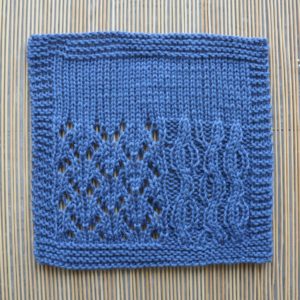
Fiber Content: 100% anti-pilling acrylic
Price point: $7.00/100g
Care: Machine wash and dry
Cable performance: Stitch definition is quite good in this yarn – cables look nice and smooth.
Lace: Lace appears a bit flat but is well-defined.
Drape: This yarn actually drapes really nicely with a good blocking. Just take care not to knit at too tight of a gauge. (Yes – you CAN block acrylic!)
Other Notes: Though some folks are not fans of man-made yarns, acrylic very much has its place in the yarn world. Uptown is very soft, not squeaky, and is a great choice for gift-knitting. This is a very versatile yarn – great for garments, accessories, blankets. It has a subtle sheen to it, and works as an alternative to those with wool allergies.
Our second contender is Deluxe DK Superwash:
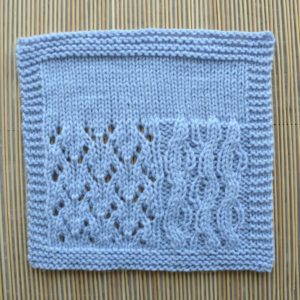
Fiber Content: 100% superwash wool
Price point: $11.00/100g
Care: Machine wash and dry
Cable performance: Stitch definition is okay. Cables don’t pop quite like they do with Dona, but softer looking cables can still be really pretty.
Lace: Lace is nice. The wool is just a bit sticky, giving openwork a slightly rustic look.
Drape: Not great with Deluxe. Though if you knit a bit looser than recommended, stockinette can be somewhat flowy.
Other Notes: Superwash wool provides the benefit of the warmth of wool, but without the hassle of having to handwash as you would with regular (non-superwash) wool. And Deluxe is quite soft for wool! This is also a versatile yarn that can be used for virtually any type of project.
Our third contender is Dona:
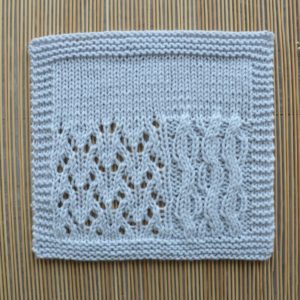
Fiber Content: 100% extrafine superwash merino wool
Price point: $10.50/50g ($21.00/100g)
Care: Machine wash and dry
Cable performance: This is the yarn you want to use for your next cabled sweater. End of story.
Lace: This yarn has a high twist which is part of what makes cables look so nice, but is also the reason that lace may not do what you hope it will. A bit of lace can look pretty in Dona, but I wouldn’t recommend it for an all-over lace shawl.
Drape: Similar to Uptown. As long as you knit a bit on the loose side and block well, this can make a somewhat drapey fabric.
Other Notes: Dona is a treat to knit with and wear. Merino wool – particularly of the “extrafine” variety that Dona is – is known for it’s softness. It’s squishy and soft and feels amazing against the skin. It’s best for sweaters and accessories, and anything that might be worn directly against the skin. Though it’s machine washable which would make it suitable for blankets, the price may be a deterrent for larger projects.
Next, we’re going to look at two non-smooth yarns. Our fourth contender is Amphora:
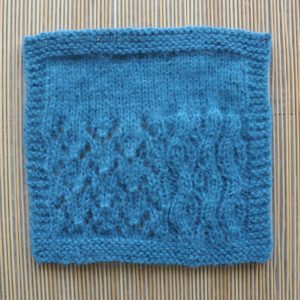
Fiber Content: 60% acrylic, 20% mohair, 20% alpaca
Price point: $14.00/100g
Care: Hand wash
Cable performance: Cables are not extremely well defined, but this can be a nice effect.
Lace: Same as cables – stitches are not going to look super sharp in this yarn – that’s the halo talking. I personally love a halo-y yarn knit in lace; it has an ethereal beauty to it.
Drape: Can drape very nicely as long as stitches are not too dense.
Other Notes: The acrylic content in this yarn is what helps keep the cost down, while the mohair and alpaca add a soft and luxurious look and feel. This yarn really shines in colorwork and stockinette sweaters, and dramatic lace shawls.
Our fifth and final contender is Unity:
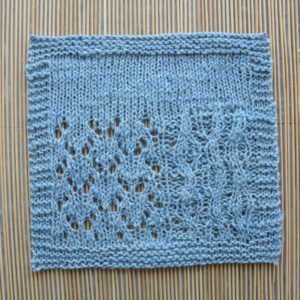
Fiber Content: 36% wool, 28% cotton, 18% linen, 18% bamboo
Price point: $12.50/100g
Care: Hand wash
Cable performance: Because this yarn has virtually no elasticity, cables have a very subtle look.
Lace: Same as cables – all stitches in this yarn are going to have a very natural, artisan look to them. Lace can pretty, but don’t expect clearly defined lines.
Drape: Excellent in most any gauge or stitch. With all of the plant fibers in this yarn, it’s no wonder.
Other Notes: I’m biased here because I love a good plant-animal fiber blend. This yarn is ever-so-slightly thick and thin, giving character to knitted fabric. Any project worked in this yarn is going to have a unique, earthy look to it. The wool mixed with the plant fibers means this is a good choice for transitional weather items (think autumn ruana or spring cardigan).
The winner of the fiber throwdown is…drumroll…wait for it…all of the yarns! What makes a yarn different from another might be exactly what makes it right for your next project. It might be because it is cheaper, hairier, softer, grabbier, more complex, smoother, or any other number of reasons.
Take our three smooth yarns, for example: Uptown DK, Deluxe DK Superwash, and Dona. To look at the photos, they don’t look strikingly different from one another. They behave similarly in most stitch patterns. Part of the limitation of an article like this is just looking at yarn and not being able to touch it. Knitting and crocheting is very tactile, and we’re all innately drawn to different things. While all of these yarns are soft, none of them feels exactly the same as the other. All three of these yarns are machine washable, but they all run the range in terms of cost. There is no “right” choice.
I hope this contentious fiber battle has given you more insight in different things to consider when selecting yarn. All yarns out there have their place and are skilled at one thing or another or many. Knitting is a process: it’s making mistakes, learning, learning from them, trying new things, and growing.


I have a sweater “Cable wise cashmere” started in Amphora. It is going to be absolutely beautiful. The cables show very well against a stockinette background. The fiber throwdown is a very good piece with very valuable information. Thanks!
This article was very helpful with its comparative samples as well as pricing of yarn/skein. The trick is remember where I read it when I am next picking yarn for a project.